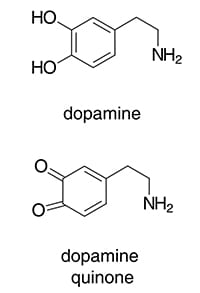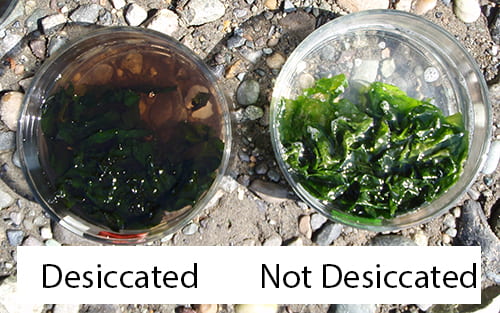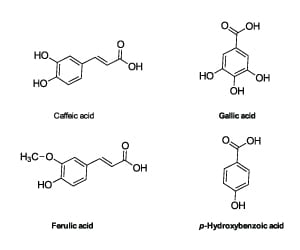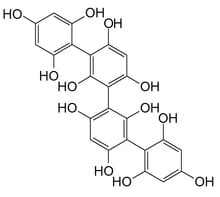Much of the research conducted by my lab is focused on the role of natural products in the ecology and physiology of marine plants and algae. My students, collaborators, and I address questions about resource allocation strategies, the adaptive value of these compounds, their effects on community structure and dynamics, the effects of environmental change on their production and efficacy, the consequences of their release into the environment, and their role in biogeochemical cycling.
Green Tides & Dopamine Production

Most people think of dopamine as a neurotransmitter found in the brains of animals; however, we have found that one of our local green tide-forming seaweeds, Ulvaria obscura (dark sea lettuce) produces dopamine as a feeding deterrent. The concentrations of dopamine we have measured in Ulvaria are about a billion-fold higher than concentrations occurring in human brains and several thousand-fold higher than the concentrations in most terrestrial plants that make it. These high concentrations of dopamine make Ulvaria distasteful to grazers. As a result, very few animals will eat it, which contributes to its ability to proliferate and form large blooms.

Dopamine also can be released into seawater if Ulvaria dries and is rehydrated, which happens during low tides on warm days. Released dopamine oxidizes rapidly and is converted into toxic, reddish-colored quinones. My lab has found that dopamine in seawater can prevent zygote germination in other algae and inhibit algal growth. It also kills or alters the development of invertebrate larvae, such as commercially important crabs. The release of allelopathic compounds such as dopamine is one of the reasons why green tide blooms are so detrimental to our coastal ecosystems.
DMS(P) in Seaweeds and Symbionts

Dimethylsulfoniopropionate (DMSP) and its breakdown products dimethyl sulfide (DMS), acrylic acid, and acrylate are produced by many seaweeds, microalgae, and by the algal symbionts of many marine animals. Because DMS is a small, volatile compound, the breakdown of algal DMSP into DMS and other compounds, helps move sulfur, which originally was taken up from seawater, into the atmosphere, where it can affect local climate by generating cloud condensation nuclei. My lab has shown that DMSP is the precursor to an activated anti-herbivore defense, and its concentrations are affected by resource availability and environmental stress.

The breakdown products of DMSP also have ecological and physiological functions. My colleagues and I have shown that DMS and acrylic acid play a role in mediating oxidative stresses in intertidal and subtidal macroalgae. DMS release is also affected by warming, desiccation, changes in salinity and herbivory in different green algal species that have different distributions on the shore. The release of DMS by algae is an important way in which sulfur is moved from the oceans to the atmosphere and our results show that rates of release by macroalgae are strongly affected by environmental conditions. These released sulfur compounds also function as airborne signaling molecules that initiate changes in animal behavior or upregulate the production of chemical defenses.
Phenolic Compounds in Seagrasses & Kelps

Seagrasses produce condensed tannins and phenolic acids that are thought to play an important role in reducing consumption by grazers and inhibiting the growth of pathogens, such as the fungi that decimated 90% of the eelgrass beds on the East Coast of North America in the 1930s. My lab is currently working in collaboration with seagrass researchers to examine the production of condensed tannins and phenolic acids in the local eelgrasses Zostera marina and Zostera japonica. We are looking at how the concentrations of compounds differ among sites that have different rates of infection of fungi and how environmental stresses affect the production of these compounds.

Marine brown algae, such as kelps and rockweeds, make complex mixtures of polyphenolic compounds that are known as phlorotannins. Phlorotannins are multifunctional compounds that can deter feeding by herbivores and act as antioxidants. My lab conducts research to look at the influence of herbivory, resource availability, and environmental stresses on the production of phlorotannins and the subsequent impacts in changes in phenolic concentrations on herbivore feeding rates and algal survival.
Chemical Signaling in the Intertidal Zone
On land, plants, herbivores, and predators use chemicals released by plants to obtain information about that plant and its interactions with its environment. For example, some plants can detect chemicals in the air that have been released by other plants that are being eaten. The detection of these compounds causes the receiving plant to upregulate genes that lead to or increase the production of chemical defenses against the herbivores consuming their neighbor. Some plants can also release airborne chemicals that signal predators or parasitoids of the herbivores that are consuming them. These chemicals are known as “infochemicals” because they convey information to the plants and animals that are able to detect them.
The importance of infochemicals in the marine environment is less well known and is mostly limited to chemicals that are transmitted directly between organisms or are carried by water. However, many intertidal plants produce small volatile compounds that are released into the air at low tide and may be capable of conveying information to other plants and algae, herbivores, and predators of the herbivores. My lab is currently studying the production and release on one of these compounds, a small sulfur-containing molecule called dimethyl sulfide (DMS). We are conducting studies to determine when DMS is released, how much is produced, and its effects on the chemistry of other intertidal plants and on the behavior of herbivores and predators.

